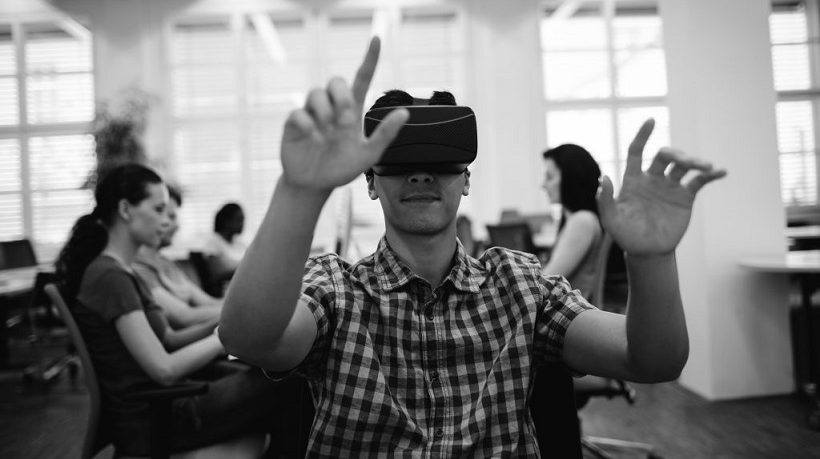Using Virtual Reality In Technical, Business, And Educational Training
The first time I ever spent quality time immersing myself in Virtual Reality gaming was at a small VR arcade that’s popped up in town. Beyond demos and brief exhibitions, I haven’t spent that much time actually experiencing VR, though I’ve written about it plenty, especially in reference to eLearning. The hour that I spent playing VR games only reinforced my belief in this medium’s potential to take over eLearning and Learning Management Systems as we know them. The feeling of immersion was profound — for a product still “in its ‘pong’ period”, as Eóghan Quigley might put it, I was thoroughly impressed with how advanced everything felt. There is no doubt in my mind that VR will completely change how we learn and train to become specialized professionals, white and blue collar employees, and even K12 students. Here’s how it’s already happening:
Virtual Reality In Technical Training
India-based Sankhya Infotech is producing eLearning simulations for over 1.5 million budding doctors, pilots, and aeronautical engineers across four different continents. Like many other LMS providers looking to the future, they are taking full advantage of data analytics and artificial intelligence in their modules, producing sims for the private medical science applications as well as national and private defense forces in over three nations across the globe.
U.S.-based public institutions from Homeland Security to the LAPD have been using VR technology to provide advanced tactical training and cost-effective disaster preparedness. With $16.1 billion in insured damages and losses due to severe thunderstorms, winter storms, heat waves, drought, and fire in 2015 alone, the benefits of low-cost immersive training could be substantial.
Sam Ryan, co-founder of Netherlands-based VR start-up Parable, couldn’t agree more. He’s developed a VR firefighting program so that staff can train more often and more efficiently, improving their level of operational readiness.
“Anything that's technically complex, expensive to operate or just plain dangerous is a good base for doing the training in virtual reality because you can do it an unlimited number of times”, he says in an article with Learning & Development Professional. “You can train in a very safe environment because it's not actually real, and it's more cost effective to do.”
Virtual Reality In Business Training
As VR training becomes more cost effective for businesses, you can bet to see adoption rates rise significantly. In fact, the UK’s largest study into the use of VR eLearning by Kallidus shows that 95% of Learning and Development professionals plan to use VR for learning in their organization, with over a third planning to roll out VR over the next three years. The same study shows that while L&D professionals would most like to see VR being used for technical skills development, health and safety training, and on-boarding/orientation, they also see potential in VR-based interpersonal, customer service, and leadership skill development.
Cost and scalability issues may be overcome much quicker than many of us realize. Pathways Training and eLearning Inc. have been working on a scalable VR solution that utilizes 360 degree video and Google’s economical cardboard VR goggles. While the first module has been designed for first responders to a simulated mass casualty event, Pathways Managing Partner Kurt Tiltack believes it will be used for much more.
“I'm rarely awestruck”, he says in the company’s official press release, “but what our team has created is simply amazing, and we see so many applications for this technology across every industry and job function”.
Tiltack and Kallidus’s assertions are backed up by business authors Marcus Johnson and Pravin Nagawade, who both assert that augmented reality and virtual reality are among the top corporate learning and business collaboration trends of 2017, with the propensity to improve company productivity by 20 to 30%.
Virtual Reality In Educational Training
This generation of students are being confronted with VR before they’ll ever reach the job market. David Matthews writing for Times Higher Education, reports that many experts have begun to believe in the application of VR. He writes:
“The promise of this kind of interactive VR education, according to advocates such as [Immersive VR Education’s founder, Dave] Whelan, is that students remember far more of what they do in such lessons, compared with what they read, hear or see in a traditional lecture theatre. They base this assertion on an educational theory called the cone of learning, invented by the American educationalist Edgar Dale in the 1960s, which ranks types of learning by how much information retention it leads to.”
Facebook founder Mark Zuckerberg could be considered among advocates such as Dave Whelan. According to VentureBeat, Zuckerberg has “revealed that he wants to ensure that education has a chance to flourish in VR. That led to him announcing a $10 million fund specifically for learning applications”.
Another draw for VR in an educational setting would be to engage students in physical activity who otherwise wouldn’t consider themselves as the traditionally athletic type. The Chicago Tribune reports that eSports has been gaining traction in high school — and if you add VR into the mix, not only will these non-traditional athletes reap the benefits of physical exercise, but they can also enjoy the benefits of combining education and interscholastic sports as well.
While only a select few Learning and Development professionals and educators have begun utilizing VR in a substantial capacity, the technology is set to overtake and redefine how we learn and train. Of course, many of those who are using VR in their eLearning courses are developing the modules themselves. If you’re one of these types, remember to follow Pau Gimeno’s 3 Keys to Introduce Virtual Reality in Your eLearning Courses. If you’re not, get in-the-know soon — VR is just getting started, and it’s here to stay.









